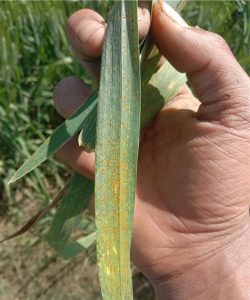Wheat (Triticum aestivum) is one of the important staple crops of India which is cultivated in the Rabi season. It contributes to a significant share in total wheat production of over 109 million tons during the year 2021. Major wheat growing states in India includes Uttar Pradesh, Punjab, Haryana, Madhya Pradesh, Rajasthan, Gujarat and Bihar.
Yellow rust also known as Stripe rust in wheat is a serious disease in India, which is a threat to wheat-growing farmers. Yellow rust may cause around 50% of yield loss, but under severe conditions, it can cause 100% yield loss. The disease can reduce yield and grain quality, leading to economic losses for farmers.
Causes of Yellow/Stripe Rust in Wheat
Yellow or Stripe rust is caused by the fungus Puccinia striiformis. It is a prevalent disease of wheat during winter or early spring months. The disease can infect all stages of wheat growth but is most damaging during the early stages of plant growth.
- Cool and damp weather conditions: Temperature of about 10-15°C, high humidity and intermittent rainfall or dew favours disease development
- Spread: The disease spreads through wind currents that causes airborne spores to travel long distances and infect healthy plants
- Lack of crop rotation: Growing the same type of wheat varieties for many years can increase disease severity
- Susceptible varieties: Growing varieties that are susceptible to wheat yellow rust influences disease spread
Symptoms of Yellow Rust in Wheat

- Small, bright yellow to orange pustules or flecks of urediospores appears on the leaves, along the veins of the leaves
- As the disease progresses, the pustules may merge together and causes necrotic stripes on the leaves
- On mature leaves, the symptom appears as linear and stripe-like pattern
- At the end of the season, teliospores appears as secondary black spores among the stripe of the pustules
- On susceptible varieties, these pustules containing yellow to orange fungal spores erupt from the leaves
- The disease symptoms may also appear in leaf sheath, neck and glumes
- It also causes chlorosis or yellowing of leaves which affects the photosynthetic activity, resulting in stunted growth with weakened plants, reduced tillering, shrivelled grains with only few spikes and reduced grain weight
Preventive Measures
- Select varieties that are region specific and resistant to yellow rust and other diseases
- Early planting can help avoid the peak period of yellow rust infection. It allows wheat to mature before the disease spreads
- Good agronomic practices, such as proper planting density, appropriate irrigation and timely weed control, can help prevent yellow rust incidence
- Follow mixed cropping and crop rotation with suitable crops such as legumes, mustard, and barley to break the disease cycle by reducing the amount of inoculum in the soil
- Avoid excessive application of nitrogenous fertilizers
- Spray Barrix control, a microbiostat at 0.3 gm/lit of water that inhibits the growth of fungus causing yellow rust
- Regularly monitor the wheat field for any signs of the yellow rust infection so that early management strategies can be opted to reduce loss
- Remove and destroy crop residues after harvest
Management of Yellow Rust in Wheat:
For effective management of yellow or stripe rust in wheat crops, combinations of both Triazoles and Strobilurin class fungicides can be sprayed to get best results.
Use the following fungicides for controlling yellow rust in wheat crop;
| Product Name | Technical Content | Dosage |
| Biological Management | ||
| Katyayani All in 1 Organic Fungicide | Organic formulation | 1.5 – 2 gm/lit water |
| V-Kure | Thymol, Eugenol, potassium salts, cationic surface agent, sodium salts & preservatives | 1.5 – 2 gm/lit water
|
| Multiplex Bio-Jodi | Pseudomonas fluorescence & Bacillus subtilis | 5 – 10 gm/lit water |
| Chemical Management | ||
| Tilt Fungicide or | Propiconazole 25 % EC | 1 ml/acre water |
| Zerox Fungicide | ||
| Indofil M-45 Fungicide | Mancozeb 75% WP | 1 gm/lit water |
| Indofil Z78 Fungicide | Zineb 75% WP | 2.5 gm/lit water |
| Custodia Fungicide or | Azoxystrobin 11% + Tebuconazole 18.3% w/w SC | 1 ml/lit water |
| Sukoyaka Fungicide | 1.5 ml/lit water | |
| Nativo Fungicide | Tebuconazole + Trifloxystrobin 75% WG | 0.5 gm/lit water |
| Amistar Fungicide | Azoxystrobin 23%SC | 1 ml/lit water |
| Godiva Super Fungicide or | Azoxystrobin 18.2% + Difenoconazole 11.4% SC | 1 ml/lit water |
| Amistar Top Fungicide | ||
| Katyayani KTM | Thiophanate Methyl 70 % WP | 1.2 – 3 gm/lit water |
| Syngenta Glo-iT | Propiconazole 13.9% + Difenoconazole 13.9% EC | 0.8 – 1.5 ml/lit water |
(NOTE: Check the product’s label before use to know the right time of spray application)
Conclusion:
Yellow or Stripe rust caused by the fungus Puccinia striiformis in wheat is a devastating disease in India that can reduce yield and grain quality. In recent years, there has been an increase in the incidence and severity of this disease. To manage the disease, farmers should regularly monitor the signs of disease incidence, take preventive measures, use fungicides judiciously and follow recommended application rates and schedules. Following these strategies can help to minimize the impact of yellow rust disease on wheat.
Click Here to learn more about Wheat Planting Methods and Package of Practices Details





